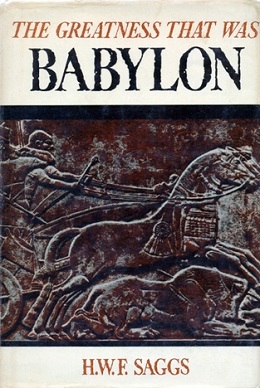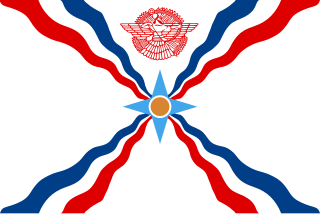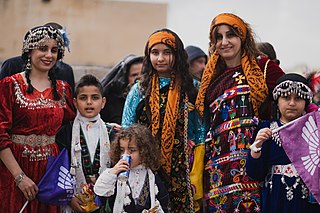
Assyria was a major ancient Mesopotamian civilization which existed as a city-state from the 21st century BC to the 14th century BC, then to a territorial state, and eventually an empire from the 14th century BC to the 7th century BC.

Chaldea was a small country that existed between the late 10th or early 9th and mid-6th centuries BCE, after which the country and its people were absorbed and assimilated into the indigenous population of Babylonia. Semitic-speaking, it was located in the marshy land of the far southeastern corner of Mesopotamia and briefly came to rule Babylon. The Hebrew Bible uses the term כשדים (Kaśdim) and this is translated as Chaldaeans in the Greek Old Testament, although there is some dispute as to whether Kasdim in fact means Chaldean or refers to the south Mesopotamian Kaldu.

The Mushki were an Iron Age people of Anatolia who appear in sources from Assyria but not from the Hittites. Several authors have connected them with the Moschoi (Μόσχοι) of Greek sources and the Georgian tribe of the Meskhi. Josephus Flavius identified the Moschoi with the Biblical Meshech. Two different groups are called Muški in Assyrian sources, one from the 12th to the 9th centuries BC near the confluence of the Arsanias and the Euphrates and the other from the 8th to the 7th centuries BC in Cappadocia and Cilicia. Assyrian sources clearly identify the Western Mushki with the Phrygians, but later Greek sources then distinguish between the Phrygians and the Moschoi.
Henry William Frederick Saggs was an English classicist and orientalist.

The Greatness That Was Babylon is a book about Babylonia by the Assyriologist H. W. F. Saggs.

Soran or Diana is a city in Erbil Governorate, and the capital of Soran District in Kurdistan Region, Iraq. Soran is one of the largest cities in Kurdistan Region with a population of about 125,000 people.
Robert D. Biggs was Professor of Assyriology in the Department of Near Eastern Languages and Civilizations at the University of Chicago. He received his PhD at Johns Hopkins University in 1962. He was an editor of the Journal of Near Eastern Studies. He retired from the University of Chicago in June 2004.

Assyrian nationalism is a movement of the Assyrian people that advocates for independence or autonomy within the regions they inhabit in northern Iraq, northeastern Syria, northwestern Iran, and southeastern Turkey.
Kuara is an archaeological site in Dhi Qar Province (Iraq). According to the Sumerian King List, Kuara was also the home of Dumuzid, the fisherman, the legendary third king of Uruk. The city's patron deity was Meslamtaea (Nergal). In Sumerian mythology, Kuara was also considered the birthplace of the god Marduk (Asarluhi), Enki's son. The cults of Marduk and Ninehama were centered in Kuara.
Tell al-Rimah is a tell, or archaeological settlement mound, in Nineveh Province (Iraq). Its ancient name may have been either Karana or Qattara. It is located in Nineveh Province (Iraq), roughly 80 kilometres (50 mi) west of Mosul and ancient Nineveh in the Sinjar region.
Tudiya or Tudia was according to the Assyrian King List (AKL) the first Assyrian monarch, ruling in Assyria's early period, though he is not attested in any known contemporary artefacts. He is listed among the “seventeen kings who lived in tents.” His existence is unconfirmed archaeologically and uncorroborated by any other source. According to the list, Tudiya was succeeded by Adamu.
Adamu was according to the Assyrian King List (AKL) the second Assyrian monarch, ruling in Assyria's early period, though he is not attested in any known contemporary artefacts. He is listed among the "seventeen kings who lived in tents" within the Mesopotamian Chronicles. The Mesopotamian Chronicles state that Adamu succeeded Tudiya. The Assyriologist Georges Roux stated that Tudiya would have lived in the 25th century BC. The earliest known use of the name “Adam” as a genuine historical name is Adamu. As in his predecessor's case, Adamu's existence remains unconfirmed archaeologically and uncorroborated by any other source.

Kurigalzu II was the 22nd king of the Kassite or 3rd dynasty that ruled over Babylon. In more than twelve inscriptions, Kurigalzu names Burna-Buriaš II as his father. Kurigalzu II was possibly placed on the Kassite throne by the Assyrian king Aššur-Uballiṭ I, reigned during a period of weakness and instability for twenty five years, eventually turning on his former allies and quite possibly defeating them at the battle of Sugagu. He was once thought to have been the conqueror of the Elamites but this now tends to be assigned to the earlier king of this name, together with the Chronicle P account.

Assyrian continuity is the theory of continuity between the modern Assyrian people, an indigenous ethnic minority in the Middle East, and the people of ancient Assyria. Assyrian continuity is a key part of the identity of the modern Assyrian people. No evidence exists of the original Assyrian population being replaced in the aftermath of the fall of the Assyrian Empire, contemporary scholarship almost unilaterally supports Assyrian continuity, recognizing the modern Assyrians as descendants of the Aramaic-speaking populations of the Neo-Assyrian Empire, which were composed of both the old native Assyrian population and of Aramean settlers in the Assyrian heartland.
Yangi was according to the Assyrian King List (AKL) the third Assyrian monarch, ruling in Assyria's early period, though he is not attested in any known contemporary artefacts. He is listed among the “seventeen kings who lived in tents” within the Mesopotamian Chronicles. Yangi is in the lists preceded by Adamu, and succeeded by Suhlamu.
The term Puqudu or Piqudu refers to a prominent Aramean tribe and its associated region in southern or eastern Babylonia. They lived along the eastern edge of Elam and in the area near Uruk and the Tigris. Their tribal name is sometimes spelled with an accent mark as Puqūdu, and the members of the tribe are sometimes referred to as Puqūdian, Puqūdians, or Puqudaeans. Some older publications use Pukud.
The Gambulu, Gambulai, or Gambuli were a tribe of Arameans in ancient Babylonia. They were the most powerful tribe along the eastern border of Babylonia, or in the south toward the border with Elam. It is difficult to pinpoint their exact location. H. W. F. Saggs places them "south of the Diyala river toward the Elamite border."
Urtak or Urtaku was a king of the ancient kingdom of Elam, which was to the southeast of ancient Babylonia. He ruled from 675 to 664 BCE, his reign overlapping those of the Assyrian kings Esarhaddon (681-669) and Ashurbanipal (668-627).
Nebuchadnezzar, also spelled Nebuchadrezzar, and most commonly known under the nickname Kudurru, was a governor of the city Uruk in Babylonia under the rule of Ashurbanipal of the Neo-Assyrian Empire, appointed after the defeat of Shamash-shum-ukin of Babylon, Ashurbanipal's brother who had rebelled against Assyria, c. 648 BC. He was likely the son of the high priest Nabonassar.
The Nimrud Letters are an archive of 244 Neo-Assyrian and Neo-Babylonian cuneiform letters found at Nimrud in 1952 during the excavations led by Max Mallowan of the British School of Archaeology. The letters were published by H. W. F. Saggs.








